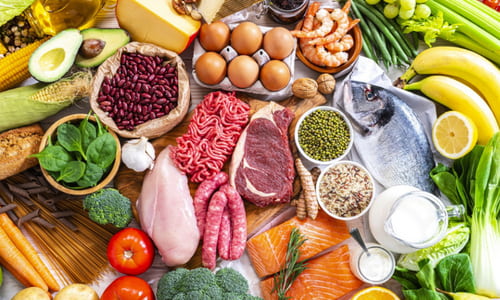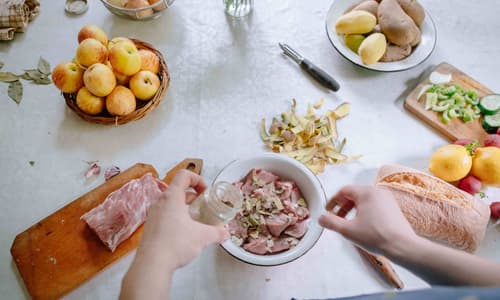High Protein Meal Prep
“High Protein Meal Prep” was written by Ashlee Mikles, RD, CD, CLS, edited by Avery Karp, & final review/edit completed by Aly Bouzek, MS, RDN. Avery is a dietetic student at Kennesaw State University.
Preparing meals ahead of time for the week can be a great and easy way to stay on track with your nutrition goals and save time while still eating delicious foods.
Balanced Meals are Key
It is important to have balanced meals that include sources of protein, carbohydrates, and fat. When your meals include all 3 of these components they will provide energy to your body and muscles AND you will feel fuller for longer.

Why Do I Need Protein?
Protein is part of the main macronutrients in meals, in addition to fats and carbohydrates. Protein is an important part of a balanced meal. Without enough protein, you can experience anemia, weakness, edema, stunted growth, and decreased immunity.
How Much Protein Do I Need Per Day?
The current protein recommendation for adults is 0.8 grams per kilogram of body weight for healthy adults with minimal physical activity. (1)
What Does High Protein Mean?
Protein needs vary. If you are more physically active, aiming to build muscle strength, or are an older adult, then you may need to eat a higher amount of protein.
New research shows that 1.0 -1.4 g protein per kilogram of body weight daily is now recommended for older adults. (2)
Here is an example of how to calculate protein needs of a 150 lb individual:
150 pounds/2.2 (kg/lb) = 68.2 kg
68.2 kg x 0.8 grams = 54.6 grams of protein OR 68.2 kg x 1 gram = 68.2 grams of protein OR 68.2 x 1.4 grams = 95.5 grams of protein.
Depending on this person’s activity level, this person should be eating 54.6 – 95.5 grams of protein per day.
It is important to talk to your doctor and a registered dietitian for personalized nutrition recommendations to find out how much protein you should be eating every day.
How to Eat Meals from Your High Protein Meal Prep
Using our above example, 54.6 – 95.5 grams of protein seems like a huge amount of protein to eat in a day! How can you eat it all?
Well, we suggest spreading that amount of protein evenly throughout your meals and snacks. Aim for 5-6 meals/snacks a day and break down that huge protein number to incorporate it!
For example, if you need 95 grams of protein a day, break it down into 3 meals and 3 snacks. This would be about 10-20 grams of protein each time you eat.
If this still seems like a big number, then scroll down to our example high proteins to see how much protein some of your favorite foods have. Eating 3 oz of chicken with your dinner will give you 24 grams of protein. Wow! Now you keep it going!
Complete vs Incomplete Proteins
It is important to keep in mind that when picking high protein foods to eat, there are different kinds of proteins.
Complete proteins include all 9 essential amino acids. Essential amino acids are amino acids that our body does not make – it’s essential that we get them from our food!
Examples of complete proteins include animal sources like:
- beef
- chicken
- fish
- dairy
- eggs
- as well as soy
These are good sources of protein to eat if you are not vegan or vegetarian.
Incomplete proteins are missing 1 or more of the 9 essential amino acids. Examples of incomplete proteins include:
- legumes
- nuts
- nut butters
- seeds
- whole grains
- vegetables
What is Meal Prepping?

Meal prepping is a convenient way to prepare several meals at once, ahead of time, that can help save a ton of time.
Meal prepping can be helpful for people with busy lifestyles and minimal time to cook but still want to stick to their nutrition goals.
Protein foods typically take longer to cook. So, when you are able to have high protein meals prepped in advance, you may be more likely to eat them!
High Protein Meal Prep Examples
Here are examples of easy, high protein foods that can be incorporated into recipes for meal prepping. Keep in mind that these are foods that can be added to several different recipes if desired.
These foods are generally higher in protein and contain minimal grams of carbohydrates and fats. (3)
| Food | Quantity | Protein (grams) |
| Chicken breast, cooked | 3 oz | 24 gm |
| Ground beef | 3 oz | 22 gm |
| Salmon | 3 oz | 22 gm |
| Soybeans | ½ cup | 16 gm |
| Hard boiled egg | 2 eggs | 12.6 gm |
| Cottage cheese | ½ cup | 12.5 gm |
| Greek yogurt | ½ cup | 11 gm |
| Whole milk | 1 cup | 8 gm |
| Black beans | ½ cup | 8 gm |
| Lentils | ½ cup | 7.8 gm |
| Tofu | 3 oz | 7 gm |
Beginner Tips for High Protein Meal Prepping
Don’t worry, prepping high protein meals doesn’t have to be hard! These tips are perfect for beginners who want to start meal prepping but don’t know how to start.
Tip #1: Pick a Day & Time to Meal Prep
Considering what day you want to meal prep is an important step. Maybe you want to start on a Sunday or Monday to prepare a couple of meals at the start of the week.
Meal prep can seem like a daunting task, especially if you are doing it alone. Try inviting some friends or family over to either help or to keep you company while you prepare a few foods for the week.
High protein tip: cook a few chicken breasts, burgers, eggs, etc. that you can use throughout the week. Flavorful chicken with High Calorie Rice can be a quick, easy, and delicious meal!
Tip #2: Start with Small, Easy Meals
Oftentimes, having a long list of ingredients and complex recipes to shop for can feel stressful. You may even feel overwhelmed with where to start.
A good starting point is to pick 1-2 recipes that you can mix and match foods with and a small amount of food that will last you 1-2 days. And if you end up not liking that recipe, you won’t have extra food go to waste.
High protein tip: eggs are a very versatile food. They can be hard boiled, scrambled, poached, you name it! With this high protein food, you can add some to every meal to make sure you’re getting enough protein throughout the day.
Try an omelet with cheese for breakfast and a hard boiled egg with one of your snacks.
Tip #3: Include Foods You May Want to Eat Later in the Week
If a recipe calls for a certain vegetable, grain, etc., then you can prepare extra of it during the initial time that you’re meal prepping. You can then save the rest of that food for a different recipe later in the week.
You can also freeze some foods to reheat quickly at a later time.
High protein tip: use a few of the cooked chicken breasts from tip #1. They can be shredded and used in tacos, sliced and put on salads, or chopped and dropped in chili.
Tip #4: Make Sure You Have the Right Cooking Equipment
You don’t need much for meal prep, but you do want to have standard cooking utensils. This may include tools like knives, cutting boards, baking sheet pans, oven, saucepans, and storage containers.
Air fryers, pressure cookers, and crock pots can also be helpful if you have those handy!
High Protein Meal Prep Wrap-up
Let us know what high protein meal prep recipes you create at home. There’s so much you can do with these foods and they can be prepared in so many different ways.
Check out our high protein articles to find foods and recipes that work for you!
References:
- Guoyao W. Dietary protein intake and human health. Food Funct. 2016;7(3):1251-1265. doi:10.1039/c5fo01530h.
- Bauer J, Biolo G, Cederholm T, et al. Evidence-based recommendations for optimal dietary protein intake in older people: a position paper from the PROT-AGE study group. J Am Med Dir Assoc. 2013;14(8):542-59. doi: 10.1016/j.jamda.2013.05.021.
- FoodData Central. USDA. Accessed September 28, 2022. https://fdc.nal.usda.gov/.
